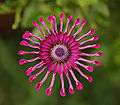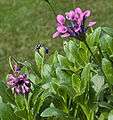Osteospermum
Osteospermum /ˌɒstiəˈspɜːrməm, -tioʊ-/,[1][2] is a genus of flowering plants belonging to the Calenduleae, one of the smaller tribes of the sunflower/daisy family Asteraceae. They are known as the daisybushes[3] or African daisies.
| Osteospermum | |
|---|---|
| Purple Osteospermum flower | |
| Scientific classification | |
| Kingdom: | Plantae |
| Clade: | Tracheophytes |
| Clade: | Angiosperms |
| Clade: | Eudicots |
| Clade: | Asterids |
| Order: | Asterales |
| Family: | Asteraceae |
| Subfamily: | Asteroideae |
| Supertribe: | Asterodae |
| Tribe: | Calenduleae |
| Genus: | Osteospermum L. |
| Species | |
|
See text | |
Osteospermum used to belong to the genus Dimorphotheca, but only the annual species remain in that genus; the perennials belong to Osteospermum. The genus Osteospermum is also closely related to the small genus Chrysanthemoides, such as C. incana and C. monilifera.
Names
The scientific name is derived from the Greek osteon (bone) and Latin spermum (seed). It has been given several common names: African daisy, South African daisy, Cape daisy and blue-eyed daisy.
Description
Their alternate (rarely opposite) leaves are green, but some variegated forms exist. The leaf form is lanceolate. The leaf margin is entire, but hardy types are toothed.
The daisy-like composite flower consists of disc florets and ray florets, growing singly at the end of branches or sometimes in inflorescences of terminal corymbose cymes. The disc florets are pseudo-bisexual and come in several colors such as blue, yellow and purple. The hardy types usually show a dark blue center in the disc until the yellow pollen is shed. The ray florets are female and are found diverse colors such as white, cream, pink, purple, mauve to yellow. Some cultivars have "spooned" petals such as "Pink Whirls". Many species flower a second time late summer, stimulated by the cooler night temperatures. Hardy types show profuse flowering in the spring, but they do not get a second flush of flowers.
Species
- Osteospermum acanthospermum
- Osteospermum amplectens
- Osteospermum attenuatum
- Osteospermum australe
- Osteospermum barberiae
- Osteospermum breviradiatum, Lemoenboegoe
- Osteospermum burttianum
- Osteospermum calendulaceum L. f., Stinking Roger (synonym of Oligocarpus calendulaceus)
- Osteospermum caulescens
- Osteospermum clandestinum (synonym of Tripteris clandestina)
- Osteospermum dentatum
- Osteospermum ecklonis (DC.) Norl., Cape marguerite, blue-and-white daisybush
- Osteospermum fruticosum (L.) Norl., Trailing African daisy, shrubby daisybush
- Osteospermum grandidentatum, Yellow trailing daisy
- Osteospermum grandiflorum
- Osteospermum hyoseroides
- Osteospermum imbricatum
- Osteospermum jucundum (Phill.) T. Norl., South African daisy
- Osteospermum microphyllum
- Osteospermum monocephalum (Oliv. & Hiern) Norl.
- Osteospermum muricatum E.Mey. ex DC.
- Osteospermum oppositifolium (synonym of Tripteris oppositifolia)
- Osteospermum pinnatum
- Osteospermum polygaloides
- Osteospermum potbergense AR Wood & B. Nord
- Osteospermum rigidum
- Osteospermum rotundifolium
- Osteospermum sinuatum (DC.) Norl. (synonym of Tripteris sinuata)
- Osteospermum spinescens
- Osteospermum subulatum DC.
- Osteospermum tomentosum
- Osteospermum triquetrum L. f.
- Osteospermum vaillantii[4]
A phylogenetic study has revealed that several changes had to be made to this genus:
- Osteospermum section Blaxium belongs in the genus Dimorphotheca
- the subgenus Tripteris had to be separated from Osteospermum
- the genus Oligocarpus has to be separated from Osteospermum
- Osteospermum sanctae-helenae, endemic to St. Helena, belongs to Oligocarpus.
New species are still being discovered, such as O. australe, O. burttianum and O. potbergense.
Distribution
There are about 70 species native to southern and eastern Africa and the Arabian peninsula.[5]
Cultivation
Osteospermum are popular in cultivation, where they are frequently used in summer bedding schemes in parks and gardens. Numerous hybrids and cultivars have been grown with a wide range of tropical colors. Yellow cultivars tend to have a yellow center (sometimes off-white).
Plants prefer a warm and sunny position and rich soil, although they tolerate poor soil, salt or drought well. Modern cultivars flower continuously when watered and fertilised well, and dead-heading is not necessary, because they do not set seed easily. If planted in a container, soil should be prevented from drying out completely. If they do, the plants will go into "sleep mode" and survive the period of drought, but they will abort their flower buds and not easily come back into flower. Moreover, roots are relatively susceptible to rotting if watered too profusely after the dry period.
Cultivars
Most widely sold cultivars are grown as annuals, are mainly hybrids of O. jucundum, O. ecklonis and O. grandiflorum and can be hardy to -2 °C (30 °F). If hardy, they can be grown as perennials or as shrubs.
Cultivars (those marked agm have gained the Royal Horticultural Society's Award of Garden Merit):[6]
- 'Acapulco'
- 'African Queen'
- 'Apricot'
- 'Biera'
- 'Big Pink'
- ‘Blackthorn Seedling’ agm[7]
- 'Bodegas Pink'
- 'Buttermilk' agm[8]
- 'Chris Brickell'
- 'Duet'
- 'Giles Gilbey'
- 'Hopleys’ agm[9]
- 'Ice White'
- 'Langtrees agm[10]
- ’Lady Leitrim’ agm[11]
- 'Lilac Spoon'
- 'Marbella'
- 'Merriments Joy'
- 'Nairobi Purple'
- 'Passion Mix'
- 'Pink'
- 'Pink Beauty'
- 'Pink Whirls' agm[12]
- 'Silver Sparkler' agm[13]
- 'Soprano'
- 'Starshine'
- 'Springstar Gemma'
- 'Sunkist'
- 'White Pim' agm[14]
- 'White Spoon'
- 'White Whirls'
- 'Whirlygig'
Image gallery
 Osteospermum barberiae
Osteospermum barberiae Osteospermum barberiae (Cape daisy)
Osteospermum barberiae (Cape daisy) Osteospermum tomentosum
Osteospermum tomentosum- 'Passion Mix'
 'Lemon Symphony' (an annual cultivar)
'Lemon Symphony' (an annual cultivar) Osteospermum 'Sunadora Hotspots Marbella', a modern hybrid
Osteospermum 'Sunadora Hotspots Marbella', a modern hybrid Osteospermum 'Sunadora Hotspots Acapulco', another modern hybrid
Osteospermum 'Sunadora Hotspots Acapulco', another modern hybrid An osteospermum displayed as part of the 2008 Penn State horticultural trials
An osteospermum displayed as part of the 2008 Penn State horticultural trials.jpg) Osteospermum 'Pink Whirls'
Osteospermum 'Pink Whirls' 'Pink Whirls' close-up
'Pink Whirls' close-up



.jpg) White Cape Daisy (Osteospermum barberiae)
White Cape Daisy (Osteospermum barberiae)
References
- "Osteospermum". Oxford Dictionaries UK Dictionary. Oxford University Press. Retrieved 2016-01-22.
- Sunset Western Garden Book, 1995:606–607
- "Osteospermum". Natural Resources Conservation Service PLANTS Database. USDA. Retrieved 26 July 2015.
- Bussmann, R. W., et al. (2006). Plant use of the Maasai of Sekenani Valley, Maasai Mara, Kenya. J Ethnobiol Ethnomed 2 22.
- "Osteospermum L." Plants of the World Online. Royal Botanic Gardens, Kew. Retrieved 2020-07-19.
- "AGM Plants - Ornamental" (PDF). Royal Horticultural Society. July 2017. p. 70. Retrieved 14 April 2018.
- "RHS Plantfinder - Osteospermum 'Blackthorn Seedling'". Retrieved 14 April 2018.
- "RHS Plant Selector - Osteospermum 'Buttermilk'". Retrieved 28 June 2013.
- "RHS Plant Selector - Osteospermum 'Hopleys'". Retrieved 28 June 2013.
- "RHS Plant Selector - Osteospermum jucundum 'Langtrees'". Retrieved 28 June 2013.
- "RHS Plantfinder - Osteospermum 'Lady Leitrim'". Retrieved 14 April 2018.
- "RHS Plant Selector - Osteospermum 'Pink Whirls'". Retrieved 28 June 2013.
- "RHS Plantfinder - Osteospermum 'Silver Sparkler'". Retrieved 14 April 2018.
- "RHS Plant Selector - Osteospermum 'White Pim'". Retrieved 28 June 2013.
Further reading
- Nordenstam, B., and Bremer, Kare (editor). "Tribe Calenduleae" in: Asteraceae: Cladistics and Classification. Portland, Oregon: Timber Press, 1994. ISBN 0-88192-275-7. Pp. 365–376.
External links
- A phylogenetic study of the Calenduleae - Bertil Nordenstam and Ida Trift
- Osteospermum.com - a website with much information and many photographs
- Sunadora Osteospermums
| Wikimedia Commons has media related to Osteospermum. |